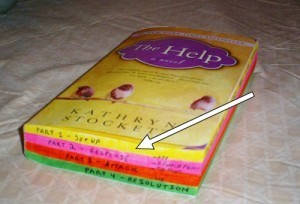"The Help" — Seeing the Structure in Living Color. Literally.
I could write until I'm blue in the face (dressed in black while wearing cool sunglasses) about how the principles of story engineering have helped me see books and storytelling like Neo sees zeros and ones in the movie The Matrix. My previous Storyfix guest post attests to this eye-opening analogy.
In doing that post I realized that writing about the benefits of proper story structure is like describing a flower—not as effective as simply showing a picture of a flower.
I needed to create a visual of story structure to drive home fully how valuable this structural model is. So I did.
Take a close look at the images below, especially the first one.
Look at the bottom of the book.
There they are, the four parts of "The Help" in full four-color glory. Four parts, four colors, each of roughly equal length. Story unveiling in quartiles, each with a unique and separate contextual mission to fulfill.
Coincidence? I think not.
As you can see, a different color represents each of the four sections of a book.
Major milestones like the first plot point and mid point are noted where they appear.
I chose yellow for the Part 1 setup because I felt that color best represented discovery.
I chose pink to represent the Part 2 response where the protagonist is reactive but unsure.
I used red to represent the Part 3 attack stage—what better color could I choose for such a contextual stage?
And I used green to represent outcome.
Each scene within these four parts is marked to allow me to remember the importance of scene execution, and study this basic building block of successful storytelling. I've even gone so far as to put the book's scene numbers and total page numbers of each scene into Microsoft Excel and plot a chart to see what patterns I can see.
Story engineering, indeed.
Larry's been telling us forever that if we break down books into their smaller compartments, each with a target mission and context, storyteling won't seem as daunting. Until I visualized "The Help" with color, I didn't completely convince myself. But when I looked at the different colored sections of this book, I said, "I'll be damned. Writing a book seems easier now."
Just like neo getting his first glimpse of the Matrix. It's always there, but only when you see it can you use it. Otherwise, it's using you.
With this visual deconstruction of The Help, I can pass down a valuable tool to my son and daughter if they ever choose to pursue a writing career too. And for this gift, I offer Larry the following graphic:
Note from Larry — no better online gift than a huge smile. Thanks to Shane for sharing this helpful tactic and his enthusiasm.
Also, please help me re-launch my 2004 critically-acclaimed novel, "Bait and Switch" on Kindle and Smashwords (coming soon to Nook and iBook). The goal is to crack the Kindle Top 100… we have a nice start with several hundred books moved over the weekend. It's up for 99 cents in July, and I'll refund your money if you don't like the read. So please give it a shot, and if you like it, tell your friends.
If we reach the Top 100 in July, I'll do an extensive deconstruction series on the book from the author's point of view, something we can't bring to the other deconstructions we show here. There is a lot of stuff going on in the mind of the author of this book, and I'll splash it on the page for you, provided enough people show interest by buying it.
Again… it's 99 cents, and it's both proven and guaranteed.
Sexy novels that turn fantasy into dangerous reality are — well, they're not hard to find, but really good ones are on the rare side, and relationship thrillers (think romances on steroids and Viagra) that that are fun to read and sometimes make you think are even rarer. That's the take on "Bait and Switch" — vicarious fun with heavy-handed themes.
Read more about this offer on my previous post, HERE.
"The Help" — Seeing the Structure in Living Color. Literally. is a post from: Larry Brooks at storyfix.com





